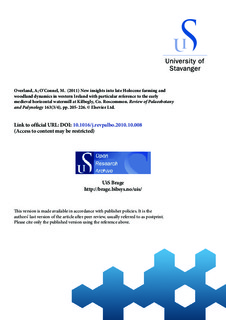| dc.contributor.author | Overland, Anette | |
| dc.contributor.author | O'Connell, Micheal | |
| dc.date.accessioned | 2014-07-31T09:16:07Z | |
| dc.date.available | 2014-07-31T09:16:07Z | |
| dc.date.issued | 2011-01 | |
| dc.identifier.citation | Overland, A; O'Connel, M. (2011) New insights into late Holocene farming and woodland dynamics in western Ireland with particular reference to the early medieval horizontal watermill at Kilbegly, Co. Roscommon. Review of Palaeobotany and Palynology 163(3/4), pp. 205-226. | nb_NO |
| dc.identifier.uri | http://hdl.handle.net/11250/199060 | |
| dc.description | © 2011 Elsevier Ltd. All rights reserved. The author accepted manuscrip is posted here with permission from Elsevier. For original article, see doi:10.1016/j.revpalbo.2010.10.008, for journal, see http://www.sciencedirect.com/science/journal/00346667/163/3. | nb_NO |
| dc.description.abstract | motorway construction, at the edge of a small mire in Kilbegly Townland, County Roscommon, provided the opportunity for palaeoecological investigations of peat and fossil moss-polster samples in a part of western Ireland where there have been few detailed pollen analytical investigations. While the data – pollen and macrofossil (moss) identifications and 14C dating – relate mainly to the early medieval period, analyses of a peat core from the mire, and a moss sample that was used as caulk in the trough of a burnt mound (fulacht fiadh), extend the environmental record well into the Bronze Age (c. 1850 cal. BC). Woodland and farming dynamics in the late Holocene are reconstructed on the basis of the investigations at Kilbegly and other sites in the region. An overview of human impact, and the intensity and nature of farming, since the mid Iron Age (c. 350 cal. BC) in Ireland is presented, based on a review of fossil pollen evidence from key sites, with due consideration being given to factors such as climate change, and cultural and related developments. The history of pine (Pinus sylvestris) and yew (Taxus baccata) is considered in some detail. The final demise of these species in the study area had occurred by the 10th century AD. | nb_NO |
| dc.language.iso | eng | nb_NO |
| dc.publisher | Elsevier | nb_NO |
| dc.subject | VDP::Humaniora: 000::Arkeologi: 090::Annen arkeologi: 099 | nb_NO |
| dc.subject | paleobotani | nb_NO |
| dc.subject | Irland | nb_NO |
| dc.subject | arkeologi | nb_NO |
| dc.subject | pollenanalyse | nb_NO |
| dc.subject | jordbruk | nb_NO |
| dc.subject | landbruk | nb_NO |
| dc.title | New insights into late Holocene farming and woodland dynamics in western Ireland with particular reference to the early medieval horizontal watermill at Kilbegly, Co. Roscommon | nb_NO |
| dc.type | Journal article | nb_NO |
| dc.type | Peer reviewed | nb_NO |
| dc.source.pagenumber | 205-226 | nb_NO |
| dc.source.volume | 163 | nb_NO |
| dc.source.journal | Review of Palaeobotany and Palynology | nb_NO |
| dc.source.issue | 3/4 | nb_NO |
| dc.identifier.doi | 10.1016/j.revpalbo.2010.10.008 | |
